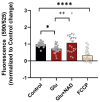Neuroprotection by Mitochondrial NAD Against Glutamate-Induced Excitotoxicity
- PMID: 40277908
- PMCID: PMC12025592
- DOI: 10.3390/cells14080582
Neuroprotection by Mitochondrial NAD Against Glutamate-Induced Excitotoxicity
Abstract
Excitotoxicity is a pathological process that occurs in many neurological diseases, such as stroke or epilepsy, and is characterized by the extracellular accumulation of high concentrations of glutamate or other excitatory amino acids (EAAs). Nicotinamide adenine dinucleotide (NAD) depletion is an early event following excitotoxicity in many in vitro and in vivo excitotoxic-related models and contributes to the deregulation of energy homeostasis. However, the interplay between glutamate excitotoxicity and the NAD biosynthetic pathway is not fully understood. To address this question, we used a primary culture of rat cortical neurons and found that an excitotoxic glutamate insult alters the expression of the NAD biosynthetic enzymes. Additionally, using a fluorescent NAD mitochondrial sensor, we observed that glutamate induces a significant decrease in the mitochondrial NAD pool, which was reversed when exogenous NAD was added. We also show that exogenous NAD protects against the glutamate-induced decrease in mitochondrial membrane potential (MMP). Glutamate excitotoxicity changed mitochondrial retrograde transport in neurites, which seems to be reversed by NAD addition. Finally, we show that NAD and NAD precursors protect against glutamate-induced cell death. Together, our results demonstrate that glutamate-induced excitotoxicity acts by compromising the NAD biosynthetic pathway, particularly in the mitochondria. These results also uncover a potential role for mitochondrial NAD as a tool for central nervous system (CNS) regenerative therapies.
Keywords: NAD metabolism; excitotoxicity; glutamate; mitochondria.
Conflict of interest statement
The authors declare that they have no conflicts of interest.
Figures






Similar articles
-
SIRT1-mediated deacetylation of PGC1α attributes to the protection of curcumin against glutamate excitotoxicity in cortical neurons.Biochem Biophys Res Commun. 2016 Sep 23;478(3):1376-81. doi: 10.1016/j.bbrc.2016.08.132. Epub 2016 Aug 24. Biochem Biophys Res Commun. 2016. PMID: 27568287
-
Conditioned medium of human adipose-derived mesenchymal stem cells mediates protection in neurons following glutamate excitotoxicity by regulating energy metabolism and GAP-43 expression.Metab Brain Dis. 2014 Mar;29(1):193-205. doi: 10.1007/s11011-014-9490-y. Epub 2014 Jan 25. Metab Brain Dis. 2014. PMID: 24458787 Free PMC article.
-
Differential Molecular Targets for Neuroprotective Effect of Chlorogenic Acid and its Related Compounds Against Glutamate Induced Excitotoxicity and Oxidative Stress in Rat Cortical Neurons.Neurochem Res. 2017 Dec;42(12):3559-3572. doi: 10.1007/s11064-017-2403-9. Epub 2017 Sep 25. Neurochem Res. 2017. PMID: 28948515
-
Glutamate excitotoxicity and Ca2+-regulation of respiration: Role of the Ca2+ activated mitochondrial transporters (CaMCs).Biochim Biophys Acta. 2016 Aug;1857(8):1158-1166. doi: 10.1016/j.bbabio.2016.04.003. Epub 2016 Apr 7. Biochim Biophys Acta. 2016. PMID: 27060251 Review.
-
Taming glutamate excitotoxicity: strategic pathway modulation for neuroprotection.CNS Drugs. 2015 Feb;29(2):153-62. doi: 10.1007/s40263-015-0225-3. CNS Drugs. 2015. PMID: 25633850 Review.
References
Publication types
MeSH terms
Substances
LinkOut - more resources
Full Text Sources

